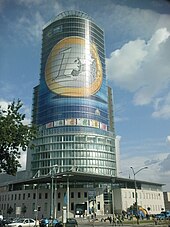

"Tatra Tiger" is a nickname that refers to the economy of Slovakia in period 2002 – 2007,[1] following the ascendance of a right-leaning coalition in September 2002 which engaged in a program of liberal economic reforms. The name "Tatra Tiger" derives from the local Tatra mountain range.
In 2004 and 2005, Slovakia had one of the highest gross domestic product growth rates in the European Union after some of the Baltic countries, reaching 6%. In 2006, the year-over-year growth amounted to an unexpected 9.8% in the 3rd quarter, which helped to increase the overall annual economic growth expectation for 2006 from 6–6.5% to 8.2%. This 9.8% growth (a low estimate) can be partly ascribed to the launch of production at a new Peugeot SA plant. The growth came as a surprise to local analysts, given that another big foreign investor, Kia, launched its production in late 2006. In 4Q of 2007, the growth was 14.3%.
However, public polling shows that despite the resultant high growth rates, the public does not universally approve of the reforms, because they are associated with a drastic loss of government programs (reform of the previously government-run health system, complete reform of the pension system, etc.), the replacement of progressive taxation with a flat tax, rapid changes of laws and other legal regulations, and rising property prices. Moreover, unemployment jumped to very high levels immediately after the reforms began in 1998, although it decreased back to its 1998 level in 2006 and even below later on. However, critics point out that the drop in unemployment was caused by the outflow of labor force abroad, after Slovakia joined the European Union in 2004, and thus the level of unemployment was not reflecting the real economic situation in Slovakia.[2]
In the first quarter of 2009 the growth of GDP was −5.7% but in 2010 it was 4.8% for the same quarter.
In the period 2005–2011 Slovakia's GDP increased by 38.3% which was the highest growth of all EU countries.[3]
- ^ Jens Jungmann,Bernd Sagemann. 2011. p. 525
- ^ Pogátsa, Zoltán (3 January 2013). "Tatranský tiger je unavený [Tatra Tiger is tired]". Pravda.sk (in Slovak). OUR MEDIA SR a. s. Retrieved 11 May 2023.
- ^ Epp.eurostat.ec.europa.eu. 11 March 2011. Retrieved 26 April 2011